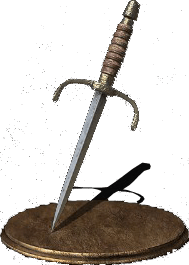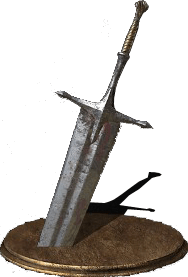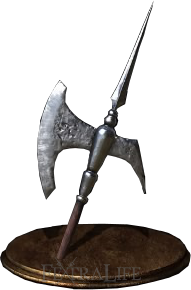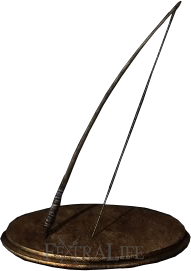Introduction
Weapons are the basic tools to deal damage in Dark Souls 3. Players may equip up to 3 in the slots for each hand. When developing a build, the player should try to find the weapon that mixes the right amount of damage, bonuses and moveset, alongside stamina consumption and Skills.
Weapon Categories
Daggers

Daggers are lightweight, small, and have fast attack speed. Their main positive is their Critical damage, which allows them to inflict incredible damage on backstabs and ripostes. Daggers do have problems that set them back; Daggers have very short-range, often requiring the user to get up close to the opponent to inflict damage; they also lack the ability to trade with heavier weapons like Greatswords, Ultra Greathammers, and Ultra Greatswords due to their low poise damage and damage without buffs.
Straight Swords

Straight Swords are the most basic type of weapon, but have solid reach and damage, fast attack speed and the Skill Stance, along with other versatile Weapon Arts. These artibutes make it an ideal choice for beginners, as well as more experienced players, considering its speed, reach and damage; they are useful both in the usual PvE mode, as well as PvP, using so called "R1 Spam", which equals to spamming the light attack in order to beat your opponent.
Greatswords

Greatswords are a high damage, long reach weapon class. If you plan on weilding greatswords, prepair to invest some points into strength; they might be required. hey have various weapon Skills ranging from Stomp to Stance to unique Skills. In terms of damage output per stamina expended, Greatswords are easily the best value weapon category, making them really useful in PvE, however, other weapon classes outperform Greatswords in PvP.
Ultra Greatswords

Ultra Greatswords usually do very high damage and have extremely slow attacks along with high Strength requirements. They benefit from "hyper armor" during certain attack animations, allowing you to continue a combo even while being struck. They also cannot be parried when two-handed, with the exception of the rolling and running attacks. There are 2 types of Ultra Greatswords; Horizontal Ultra Greatswords, which are good for hitting multiple opponents due to its wide range, while with Vertical Ultra Greatswords, normal attacks turn into vertical slams once they are 2-handed and have the ability to hit behind the user when the second normal attack is used.
Curved Swords

Curved Swords are a generally a Dexterity-based weapon class with fast swing speeds, decent damage and range, and a excellent roll-catching abilities. However, there are some negatives to Curved Swords; players with high Poise and heavier weapons like Greatswords, Ultra Greatswords, and Great Hammers players will be able to tank-out hits/parry these players easily. Curver Swords attract beginners due to their positives, and are widely used in both PvE and PvP modes.
Katanas

Katanas usually do moderate to good damage and deal Bleed. These weapons have particularly strong running attacks. Like curved swords, they utilize primarily on slashing attacks. While useful in many scenarios, such as PvP, their main downfall is their low durability, and therefore u should be careful when using them in PvE mode.
Curved Greatswords

Curved Greatswords usually do a good deal of damage per swing, but have slower attacks. Sometimes they also possess Auxiliary effects such as Bleeding or Poison. Like katanas, they also have a lower than usual durability, so be careful when using them in the long run, such as in PvE.
Piercing Swords

Thrusting Swords (Piercing Swords) usually do little to moderate damage per swing, but attack rather quickly, have good reach, and are capable of punishing counter-attacks rather well. Most of them can also attack froh behind a shield. Thrusting Swords replace the kick with a quick retreating attack that does minor damage.
Axes

Axes usually do decent damage and are best used on Strength/Quality builds. Most of the Axes have the Skill Warcry, which provides the weapon with a damage boost for 30 seconds. They are generally considered worse than straight swords, due to their lower attack speed, weaker damage output, and having an arguably worse moveset and Skill spread. However, they provide you with higher damage, and can roll-catch quite well.
Greataxes

Greataxes are larger versions of their Axe counterparts and are usually wielded two-handed, due to their strength requirements and overall better usage. These Weapons usually do very high damage and have slower attacks. Great Axes tend to do more AoE attacks than Greatswords, but they're similar to each other otherwise.
Hammers

Hammers is a general term for Maces and the like. Hammers generally attack the slowest of most traditional one-handed weapons, but generally deal the most damage per swing. Two-handing hammers is also a viable option with some choices like the Mace, or Reinforced Club.
Great Hammers

Great Hammers are one of the largest weapon types in the game. They have a slower movesets but feature high damage and are an intimidating choice for players. They also have the highest poise damage of any weapon class in the game, with 45 poise damage on a regular two handed light attack. Great Hammers also cannot be parried two-handed, with the exception of the rolling and running attack.
Fist & Claws

Fist & Claws usually have similar movesets albeit with different skills and properties. Fists and Claws are often used as parrying tools, due to their fast parry frames. Fist weapons have a faster light attack than Claws and a different rolling R1, but have shorter range and lack the innate Bleed Auxiliary effect that Claws have. Claws have a slightly slower light attack than Fist weapons but have considerably different movesets when two handed (the Crow Talons especially). Claws have greater range than the Fists and have innate Bleed.
Spears & Pikes

Spears & Pikes have long reach and are excellent for dealing damage while remaining defensive. Spears & Pikes function well when paired with a shield, particularly greatshields, as they have relatively moderate stamina consumption and can be quickly thrusted without lowering your guard. These weapons require patience and careful spacing to make proper use of, but are capable of punishing counterattacks. Their most common Skill is Charge.
Halberds

Halberds usually do moderate damage and have long reach. Halberds are generally either a fusion between a spear and another weapon, thus combining straight thrusting attacks and wide swinging strikes, or are simply a cutting or chopping weapon on a long shaft, which is swung across and overhead at a distance. These weapons often have trouble performing in close range or tight quarters.
Reapers

Reapers have long reach and a unique sweeping moveset, and most are Bleed weapons. These weapons are particularly useful for sneaking damage behind shields, when swung with proper spacing. Reapers have a "sweet spot" in which they will do bonus damage when swung at the precise range that their blade reaches the target, and will perform less powerfully when struck with the shaft of the weapon if you are too close to the target. Reapers will also deal chip damage through shields if the "sweet spot" lands, even if the shield has a 100% physical block.
Whips

Whips usually do little to moderate damage, and perform poorly against well-armored foes, but have long reach and can have Auxiliary effects such as Bleeding or Poison. Unlike other melee weapons, whips cannot be parried but cannot backstab or riposte.
Bows

Bows have changed a bit in Dark Souls 3. Different Bow types have different attack speeds, ranges and damage. They require arrows and usually a decent amount of Dexterity. It will be possible to use a Short Bow in melee range. Bows can not be infused.
Greatbows

Greatbows are extremely powerful version of Bows that can knock enemies off their feet in a single shot, in exchange for how demanding they are to use. Operating these weapons demand the operator stop moving entirely, and drawing a greatbow is a time consuming process that leaves the user vulnerable.
Crossbows

These Weapons usually do moderate damage and have less range than Bows. They are generally more close ranged weapons, allowing players to "shoot from the hip" and reload on the move without entering a two-handed stance. These weapons do not scale with stats, and as a result are less useful on consecutive NG+ runs. Crossbows use Bolts.
Staves

Staves are wielded in order to cast Sorceries. Casting Sorceries consumes Focus Points. Their Skill buffs the power of cast spells for a short duration. Sorceries are a viable, but often disliked options in PvP, due to the fact that they're simple to use and generally require little to no skills.
Flames

Flames are a type of Weapon in Dark Souls 3. These Weapons allow the player to cast Pyromancies. The base game has only one Flame, with the Ashes of Ariandel DLC adding a second one and The Ringed City DLC adding a Curved Sword (Demon's Scar) that doubles as a Pyromance Flame.
Talismans

Talismans are wielded in order to cast Miracles. These items were not present in Dark Souls 2, but make a return here. The most commonly found Skill among them, Unfaltering Prayer, differentiates them from Chimes and turns them towards PvP use. Not meeting the Faith requirement for the Talisman will drop the spell buff to a flat 60.
Sacred Chimes

Sacred Chimes are a type of Weapon that replaced Talismans in Dark Souls 2, but now, both have returned in Dark Souls 3. These Weapons are used to cast Miracles, as well as some cases of Sorceries. The most common Skill they have is Gentle Prayer, differentiating them for the Talismans.